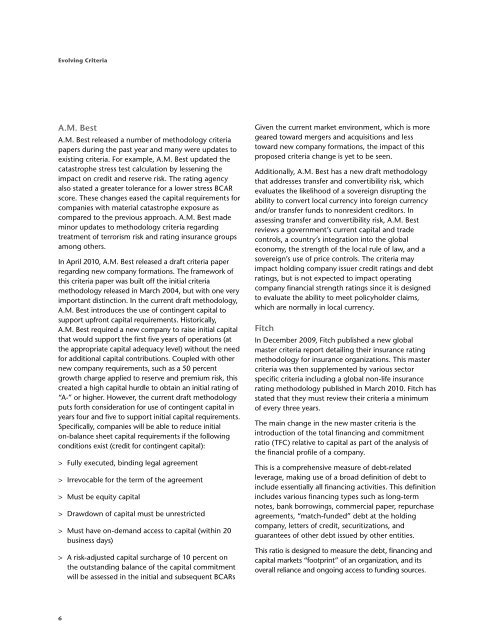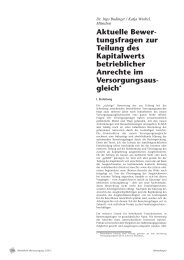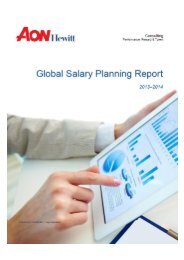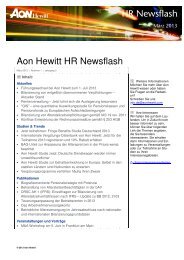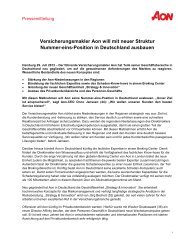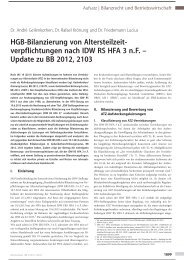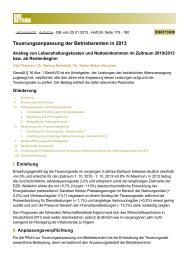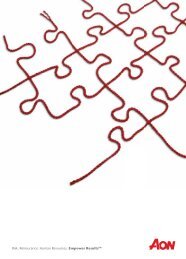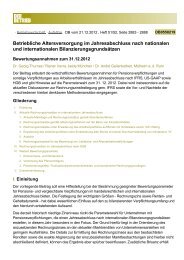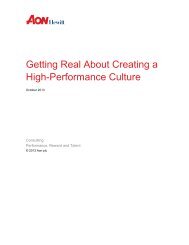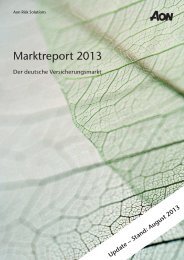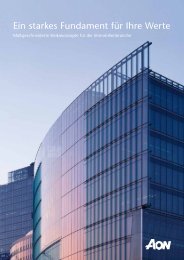Evolving Criteria - Reinsurance Thought Leadership | Aon Benfield
Evolving Criteria - Reinsurance Thought Leadership | Aon Benfield
Evolving Criteria - Reinsurance Thought Leadership | Aon Benfield
Create successful ePaper yourself
Turn your PDF publications into a flip-book with our unique Google optimized e-Paper software.
<strong>Evolving</strong> <strong>Criteria</strong><br />
A.M. Best<br />
A.M. Best released a number of methodology criteria<br />
papers during the past year and many were updates to<br />
existing criteria. For example, A.M. Best updated the<br />
catastrophe stress test calculation by lessening the<br />
impact on credit and reserve risk. The rating agency<br />
also stated a greater tolerance for a lower stress BCAR<br />
score. These changes eased the capital requirements for<br />
companies with material catastrophe exposure as<br />
compared to the previous approach. A.M. Best made<br />
minor updates to methodology criteria regarding<br />
treatment of terrorism risk and rating insurance groups<br />
among others.<br />
In April 2010, A.M. Best released a draft criteria paper<br />
regarding new company formations. The framework of<br />
this criteria paper was built off the initial criteria<br />
methodology released in March 2004, but with one very<br />
important distinction. In the current draft methodology,<br />
A.M. Best introduces the use of contingent capital to<br />
support upfront capital requirements. Historically,<br />
A.M. Best required a new company to raise initial capital<br />
that would support the first five years of operations (at<br />
the appropriate capital adequacy level) without the need<br />
for additional capital contributions. Coupled with other<br />
new company requirements, such as a 50 percent<br />
growth charge applied to reserve and premium risk, this<br />
created a high capital hurdle to obtain an initial rating of<br />
“A-” or higher. However, the current draft methodology<br />
puts forth consideration for use of contingent capital in<br />
years four and five to support initial capital requirements.<br />
Specifically, companies will be able to reduce initial<br />
on-balance sheet capital requirements if the following<br />
conditions exist (credit for contingent capital):<br />
> Fully executed, binding legal agreement<br />
> Irrevocable for the term of the agreement<br />
> Must be equity capital<br />
> Drawdown of capital must be unrestricted<br />
> Must have on-demand access to capital (within 20<br />
business days)<br />
> A risk-adjusted capital surcharge of 10 percent on<br />
the outstanding balance of the capital commitment<br />
will be assessed in the initial and subsequent BCARs<br />
6<br />
Given the current market environment, which is more<br />
geared toward mergers and acquisitions and less<br />
toward new company formations, the impact of this<br />
proposed criteria change is yet to be seen.<br />
Additionally, A.M. Best has a new draft methodology<br />
that addresses transfer and convertibility risk, which<br />
evaluates the likelihood of a sovereign disrupting the<br />
ability to convert local currency into foreign currency<br />
and/or transfer funds to nonresident creditors. In<br />
assessing transfer and convertibility risk, A.M. Best<br />
reviews a government’s current capital and trade<br />
controls, a country’s integration into the global<br />
economy, the strength of the local rule of law, and a<br />
sovereign’s use of price controls. The criteria may<br />
impact holding company issuer credit ratings and debt<br />
ratings, but is not expected to impact operating<br />
company financial strength ratings since it is designed<br />
to evaluate the ability to meet policyholder claims,<br />
which are normally in local currency.<br />
Fitch<br />
In December 2009, Fitch published a new global<br />
master criteria report detailing their insurance rating<br />
methodology for insurance organizations. This master<br />
criteria was then supplemented by various sector<br />
specific criteria including a global non-life insurance<br />
rating methodology published in March 2010. Fitch has<br />
stated that they must review their criteria a minimum<br />
of every three years.<br />
The main change in the new master criteria is the<br />
introduction of the total financing and commitment<br />
ratio (TFC) relative to capital as part of the analysis of<br />
the financial profile of a company.<br />
This is a comprehensive measure of debt-related<br />
leverage, making use of a broad definition of debt to<br />
include essentially all financing activities. This definition<br />
includes various financing types such as long-term<br />
notes, bank borrowings, commercial paper, repurchase<br />
agreements, “match-funded” debt at the holding<br />
company, letters of credit, securitizations, and<br />
guarantees of other debt issued by other entities.<br />
This ratio is designed to measure the debt, financing and<br />
capital markets “footprint” of an organization, and its<br />
overall reliance and ongoing access to funding sources.


